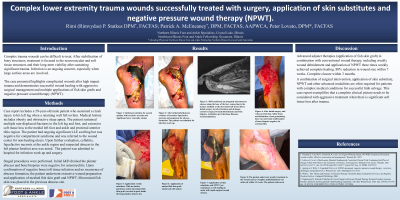Case Series/Study
(CS-132) Complex lower extremity trauma wounds successfully treated with surgery, application of skin substitutes and negative pressure wound therapy (NPWT).

Complex trauma wounds can be difficult to treat. After maintaining stable bony structures, concern is focused to the neurovascular and soft tissue structures and their long-term viability after sustaining significant trauma. Infection is always an ongoing concern especially when large surface areas are involved.
The case presented highlights complicated wounds after the patient sustained a high impact trauma and demonstrates successful wound healing with aggressive surgical management and multiple applications of fish skin grafts and negative pressure wound therapy (NPWT).
Methods:
Case report includes a 59-year-old male patient with medical history including obesity and obstructive sleep apnea sustained a crush injury to his left leg when a retaining wall fell on him. The patient sustained multiple non-displaced fractures to the left leg and foot. The patient sustained extensive soft tissue loss to the medial left foot and ankle and proximal anterior tibia region. The patient had ongoing LLE swelling but was negative for compartment syndrome. The patient was referred to the wound center for non-healing ulcers. Upon initial evaluation, there was cellulitis, liquefactive necrosis at the ankle region and suspected abscess to the left plantar forefoot area. The patient was admitted to hospital for infection work up and surgery.
Staged procedures were performed. Initial I&D drained the plantar abscess and bone biopsies were negative for osteomyelitis. Upon confirmation of negative bone/soft tissue infection and no recurrence of abscess formation, the patient underwent extensive wound preparation and application of meshed fish skin graft and NPWT. Micronized fish skin was placed in the previous abscess site.
Results:
Advanced adjunct therapies (application of fish skin graft) in combination with conventional wound therapy including weekly wound debridement and application of NPWT three times weekly achieved complete healing. 80% reduction in wound size within 7 weeks (with wound size initially 399 square cm down to 84 square cm).
Discussion:
A combination of surgical intervention, application of skin substitute, NPWT and other advanced modalities are often required for patients with complex medical conditions for successful limb salvage. This case report exemplifies that a complete clinical picture needs to be considered with aggressive treatment when there is significant soft tissue loss after trauma.
Trademarked Items:
References:

.png)